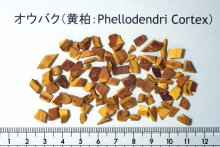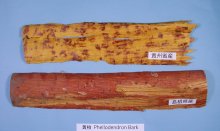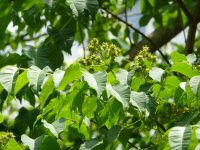Japanese Folk Medicine
-Vol. 2 - Phellodendri Cortex (Phellodendron Bark) -黄柏-

-
 Drug for dispensing
Drug for dispensing
(Phellodendron Bark) -
 Phellodendron Bark
Phellodendron Bark -
 Phellodendron amurense Ruprecht
Phellodendron amurense Ruprecht
Origin
Phellodendri Cortex (obaku in Japanese) is the bark peeled off the periderm of the deciduous tree species Phellodendron amurense Ruprecht (kihada in Japanese), which belongs to the Rutaceae family. It is described in the sixteenth Japanese Pharmacopoeia.
P. amurense is native to East Asia, e.g., Japan, the Korean Peninsula, northern China, the Amur area, and the Ussuri region. In Japan, it grows from the mountains of Hokkaido to Kyusyu.
P. amurense is a dioecious tree (height: 15 to 20 meters) with a trunk that reaches about 50 to 100 centimeters in diameter. The cork layer of its bark is well developed. Its bark is light brownish-yellow in color and displays deep longitudinal furrows, and its endodermis is bright yellow. Its branches are wide and form an umbrella-shaped crown. It possesses imparipinnate leaves with 5 to 13 folioles, which are narrow-ovate or oblong-ovate, 5 to 10 centimeters wide, and have an entire margin and a caudate-acuminate tip. Its flowering season lasts from May to June, and it produces panicles made up of branches with small yellow-green flowers on their tips. It also produces a stone fruit, which turns black as it ripens and is found from September to October.
The dry bark (inner bark) is called obaku and is used as a digestive medicine. In addition, the fruit is used as a decongestant, anthelmintic, and digestive medicine. The wood is used as a construction material (for alcove posts and floorboards, etc.) as well as to make furniture (bookshelves and dressers, etc.) and utensils (wooden bowls and tea caddies, etc.).
To produce the crude drug, the bark of trees that are at least 12- to 13-years-old is peeled off during the hottest season, the cork layer is removed, and then the bark is dried in the sun.
Some other Phellodendron tree species also grow in Japan; i.e., P. japonicum (obanokihada, fujikihada, nikkoukihada) grows in Hakone and at the foot of Mt. Fuji; P. lavallei (miyamakihada) is found in the Chugoku region of Honshu and Hokkaido; and P. sachalinense (hirohanokihada, karafutokihada) occurs in northern Honshu and Hokkaido (as well as Sakhalin, Korea, and China). The bark of Chinese P. chinense (shinakihada, 黄皮樹) and Taiwanese P. wilsonii (taiwankihada) is also sold at local markets.
History
The scientific name Phellodendron is derived from a combination of phellos (meaning cork) and dendron (meaning timber), and amurense is derived from a combination of amur (indicating the Amurskaya region) and -ense (genitive). The name kihada (黄肌) originates from the yellow color of the inner bark, which is revealed when the outer bark is peeled off. Phellodendri Cortex is described in the 'Shennong Ben Cao Jing (神農本草経)' under the name hakuboku (檗木) and in the 'Zhongyao-dacidian (中薬大辞典)' under the name obaku (黄柏, 黄檗). In Japan, there are also various local names for kihada belonging to Phellodendron species, e.g., shikoro or shikerebeni in Hokkaido, shikoro or shikonohe in Aomori and Iwate prefectures; shikonoki in Yamagata and Niigata prefectures; sanzenso in Saitama, Yamanashi, Shizuoka, and Gifu prefectures; and ohegi in Okayama and Hiroshima prefectures.
The dried inner bark is called Phellodendri Cortex, and it has been used as a folk medicine all over Japan since ancient times because berberine, its principal compound, and its extract have strong antibacterial effects, and hence, are used as medicines for gastrointestinal disease. In fact, some famous medicines are mainly composed of water extract of Phellodendri Cortex, e.g., daranisuke (陀羅尼助) is used in the Yoshino region of Nara prefecture, nerikuma (練熊) is used in the San'in region, and hyakuso (百草) is used in the Ontake Mountains in Shinshu, and some of these medicines are still used quite frequently today.
High priests used daranisuke (陀羅尼助) to stimulate their pupils when teaching them the Buddhist sutra daranikyo (陀羅尼経) , which is how it got the name daranisuke. The medicine takes the form of glistening black-brown plates and is wrapped in a bamboo sheath. It is made by boiling pieces of Phellodendri Cortex (80%), Aucuba leaves (10%), and Gentianae Scabrae Radix (10%) in a cauldron. The boiling process is repeated three times to filter out impurities. The boiled liquid, which is yellow at first, gradually becomes black-brown and eventually takes a concentrated candy-like form. The candy-like medicine is wrapped in a bamboo sheath and then dried in the sun to produce the final product. One gram of the final product is taken with hot or room temperature water before meals 3 times a day. Daranisuke has recently become available in pill form and is used against gastritis, duodenal catarrh, weak digestion, indigestion, upset stomach, and food poisoning.
Nerikuma (練熊) is said to be composed of 100% Phellodendri Cortex extract, and 1 g of hyakuso (百草) product contains 0.4 g of Phellodendri Cortex extract, 0.4 g of Geranii Herba, and 0.2 g of Gentianae Radix powder, and these medicines have similar effects to daranisuke (陀羅尼助).
Compounds
The bark of Phellodendron amurense contains the following compounds: alkaloids (berberine, jatrorrhizine, magnoflorine, phellodendrine, candicine, palmatine, and menisperine, etc.), bitter tasting terpenoids (obacunone and limonin), and linolenic acid, b-sitosterol, etc. Berberine is also present in the root bark and wood.
Pharmacological effects and toxicity
The pharmacological effects of Phellodendri Cortex are similar to those of Coptidis Rhizoma because both of them contain a relatively large amount of berberine. However, their pharmacological effects are not identical because the berberine content of Phellodendri Cortex is lower than that of Coptidis Rhizoma, and Phellodendri Cortex also contains other compounds.
Berberine has strong antibacterial and disinfectant effects against Gram-positive and Gram-negative bacteria; disinfectant effects against Escherichia coli, Bacillus typhosus, and cholera bacillus; and strong antibacterial effects against Staphylococcus aureus, Neisseria gonorrhoea, and Bacillus dysenteriae. Although the antibacterial effect of Phellodendri Cortex is half the strength of that of Coptidis Rhizoma, due to its bitter taste it is used as a stomachic and intestinal remedy in Kampo formulae and as an antidiarrheic, stomachic, and intestinal remedy in folk medicine.
The oral administration of Phellodendri Cortex decoctions results in an initial increase in the patient's blood glucose level followed by a decrease. The ethanol extract of Phellodendri Cortex produces a transient increase in the patient's blood glucose level followed by a marked decrease after 6 hours. It also has a choleretic effect, increases pancreatic secretion, and weak diuretic effects and has been demonstrated to increase insulin secretion in rabbits with pancreatic fistulae (Zhongyao-dacidian [中薬大辞典]).
Phellodendri Cortex has also been reported to lower blood pressure, depress the central nervous system, and increase the patient's acetylcholine level. A marked and persistent blood pressure-lowering effect is observed after the intravenous or intraperitoneal infusion of Phellodendri Cortex products in anesthetized animals, while the effect is stronger when Phellodendri Cortex is injected into the carotid artery, it may act central nerve. Phellodendrine has a depressant effect on the central nervous system, e.g., it suppresses spontaneous activity and reflex actions in mice. Phellodendrine also has a similar effect to curare; i.e., it suppresses acetylcholine-based contractile responses in frogs while it does not influence the level of tension in the rectus abdominis muscle. As for its constrictive effect on peripheral vessels, the medicine has an inhibitory effect on the movement of isolated intestinal canals and rabbit uteri (Zhongyao-dacidian [中薬大辞典]).
Phellodendri Cortex has insecticidal effects against caterpillars (62% of caterpillars are killed within 18 hours of being treated with 10 ppm of the medicine) and flies (Zhongyao-dacidian [中薬大辞典]).
Medicinal effects, dosage, and administration
Phellodendri Cortex is considered to be able to cool fever, dry dampness, and put out fire and to have detoxifying effects. The Zhongyao-dacidian (中薬大辞典) also states that the medicine can cure various ailments, e.g., diarrhea caused by hotness, simple diarrhea, diabetes, jaundice, paraplegia, nocturnal emission, pollution, cloudy urine, hemorrhoids, bloody stools, bloody vaginal discharge, and painful red eyes. In Kampo, Phellodendri Cortex is considered to cool fever, dry dampness, have detoxifying effects , and cool xure (虚熱), and it is used in various Kampo formulae that are used to treat diarrhea, diabetes, jaundice, cystitis, piles, vaginal discharge, phthisis, eczema, and swelling. In particular, Phellodendri Cortex is effective against 'fever caused by dampness in the lower body (下焦)' and is used to treat diarrhea, urine disorders, abnormal genitalia, and nervous symptoms in the lower extremities, etc.
It is used in combination with Anemarrhenae Rhizoma to treat fever caused by debilitating diseases (xure: 虚熱), fever caused by phthisis, chronic bronchitis (jiinkokato:滋陰降火湯), nephrophthisis, and chronic urinary tract infection (chibakujiogan: 知柏地黄丸). In addition, it is used together with Rehmanniae Radix and Astragali Radix to treat slight continuous fever with sweating (tokirikuoto: 当帰六黄湯).
It is mixed with Atractylodis Lanceae Rhizoma and Achyranthis Radix to treat arthritis, paralysis, and numbness in the lower extremities (nimyosan: 二妙散). Moreover, it is used alone or together with Pulsatilla Radix and Phellodendri Cortex to treat bacterial or amebic diarrhea (hakutooto: 白頭翁湯). When combined with Gardeniae Fructus, it can be used as a treatment for jaundice with a combination of abnormal urine and normal bowel movements (shishihakuhito: 梔子柏皮湯), and it also used as an external medicine for treating suppuration or bruising (chuoko: 中黄膏).
Furthermore, Phellodendri Cortex is also found in the Kampo medicines unseiin (温清飲), orengedokuto (黄連解毒湯), and seisyoekkito (清暑益気湯), etc., as well as in some general-purpose medicines, i.e., seirogan (正露丸) and wakamatsujo (ワカ末錠).
As for folk medicine, a decoction in which 3 to 6 g of Phellodendri Cortex are decocted with 400 mL of water until roughly half of the water has evaporated is used 3 times a day as a treatment for gastrointestinal disease and bacterial diarrhea. Alternatively, 0.3 to 0.5 g (for a dose) of Phellodendri Cortex powder can be taken directly. It is also effective as an external medicine, e.g., the decoction is used as an eyewash for treating ophthalmopathy, bleary eyes, and conjunctivitis and is used as a mouthwash to treat stomatitis and adenoiditis. Moreover, a paste prepared from Phellodendri Cortex powder, flour, and Gardeniae Fructus powder (5:3:2) mixed with egg albumin and vinegar can be spread on the affected area in patients.
Others
Kihada liquor, which is made from Phellodendri Cortex, is a health drink produced from 20 g of Phellodendri Cortex mixed with 1.8 L of white liquor. Although sugar crystals or honey can be added to it, it is more effective as a health drink if it does not contain either of these. After storing it for about three months, it is strained through cloth. The liquor is a beautiful sunny yellow color and has a refreshingly bitter taste. It is appreciated as a pre-dinner drink. The liquor is also used for people with slight diarrhea, who are advised to drink it 3 times a day between meals.
The inner bark of P. amurense has also been used as yellow dye. It contains the yellow pigment berberine, a natural alkaline pigment, and silk and wool can be dyed yellow by soaking them in slightly acidic warm water containing P. amurense. The pigment also repels insects, so yellow paper that had been dyed with Phellodendri Cortex was used for official governmental documents in ancient China. In Japan, such yellow paper was described in literature written in the Tenpyo era. In fact, the Shosoin (a treasure house) of Todai-ji temple (Nara, Japan) contains sutras that have been transcribed on yellow paper dyed with Phellodendri Cortex.
P. amurense grows in full sunlight, and both moderate and wet climate are suitable growing environments because it is able to adapt to wet climates. Fertile, well-drained, and wet soil; i.e., humic sandy soil, is best for cultivating P. amurense. The plant is easy to grow and has strong germination ability.
Reference
F. Ikegami, Wakanyaku, 689, 8-9, (2010.10)
